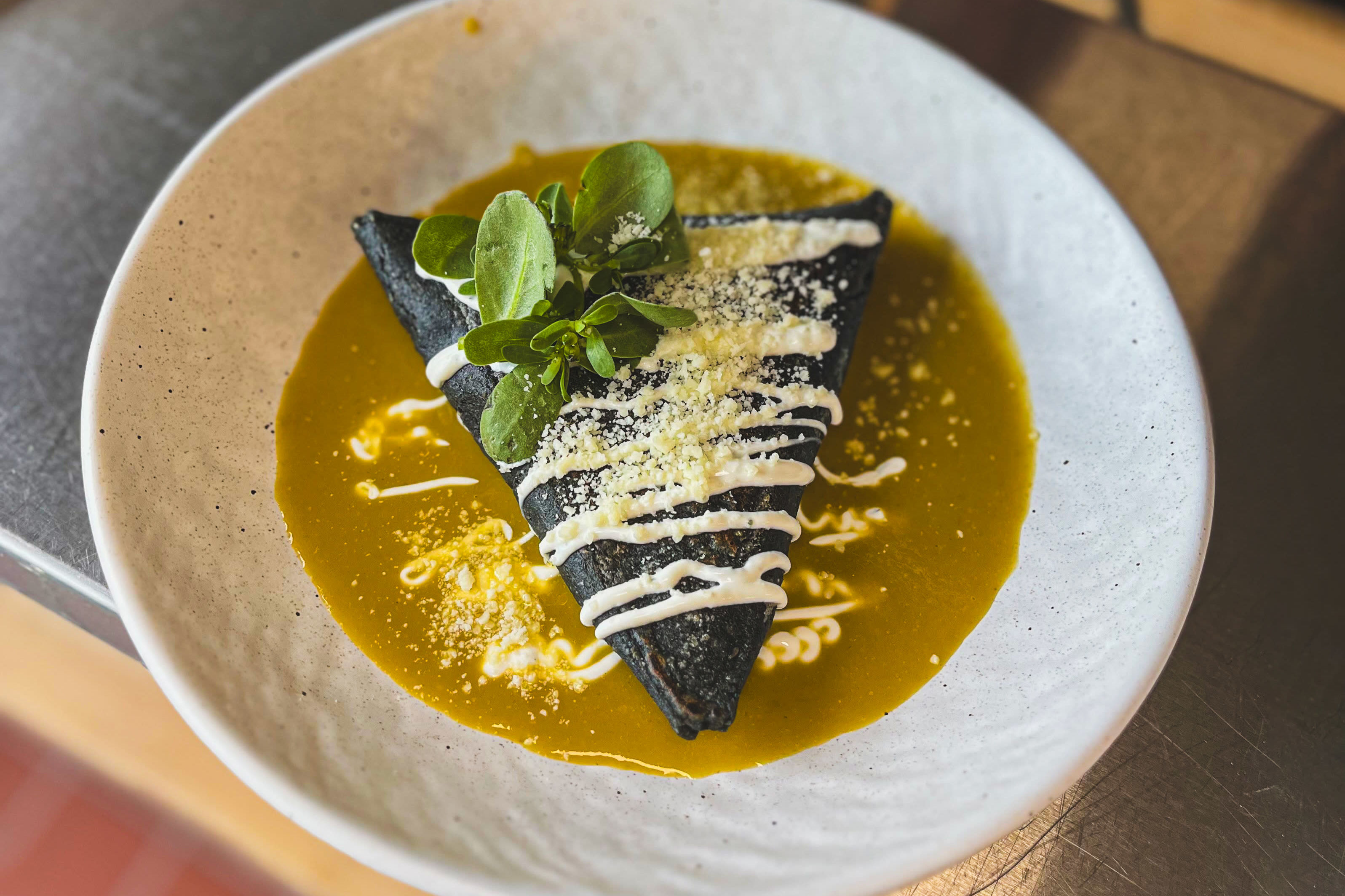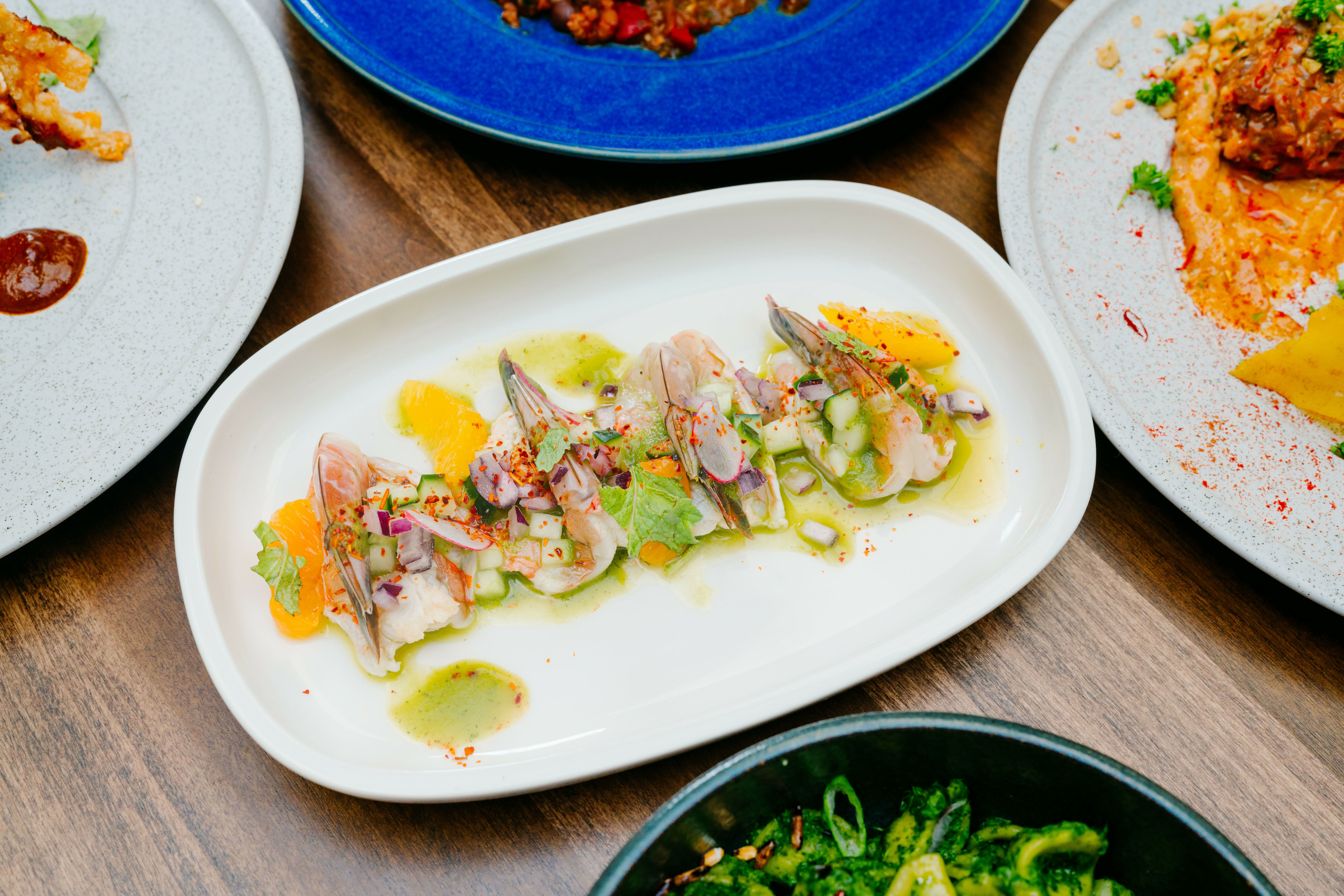Houston Chefs Use Nopales to Connect Back to Mexico

Victoria Elizondo, chef-owner of Cochinita & Co., shops for prickly pear at the Houston Farmers Market.
Image: Michael Anthony
In today’s Houston dining scene, prickly pear cactus represents an ancient and organic bond with Mexico. Cactus paddles—called nopales, or nopalitos in their diced-up form—are iconic in Mexican cuisine and show up in a variety of dishes across the city.
Both Texans and Mexicans have boiled, roasted, baked, and sautéed cactus for millennia. Texas archaeological and historical evidence shows that nopales were first domesticated and enjoyed in central Mexico, and that Native ancestors have been eating them the past 9,000 years. Over time, the landscapes from Houston to Mexico City grew into a natural home for the bright green succulent plant whose young, tender paddles make for delicious dining.
Nopalitos also speak to identity. The prickly pear cactus is emblazoned on the coat of arms of Mexico, and Texas claims it as the official state plant. Many Houston chefs and restaurant owners celebrate this ancestral connection with nopalito dishes that are world-class expressions of Mexican gastronomy while showing the evolution of the cuisine on this side of the border.

Cochinita & Co.’s cactus salad is a must-order at the East End spot.
Image: Michael Anthony
Victoria Elizondo is one of these chefs. The 2023 James Beard Award semifinalist for Emerging Chef makes a bona fide feast of the nopalitos salad she serves at her East End restaurant, Cochinita & Co., by going beyond the traditional ingredients that normally make up this cactus dish. To the classic salad blend of pico de gallo, fresh green chiles, and queso fresco, Elizondo adds the crunch of diced jicama and corn kernels that are slightly roasted. It’s all tossed in an oregano-forward vinaigrette that she sweetens by adding liquefied golden raisins. Unique and colorful, the nopalitos salad is served with three golden, crunchy mini-tostadas.
Over at Soto’s Cantina in the Willowbrook area, chef Juan Soto serves a dish he calls quinoa Potosina, meaning that it is in the style of San Luis Potosí, where he grew up among cactus plants both in the fields and cooked at the family dining table. Here at his Houston restaurant, Soto mixes cactus strips with cooked quinoa in an imaginative blending of the tartness of cactus with the nutty undertones of quinoa. It’s an innovative combination of not just flavors but of two superfoods, both rich in antioxidants and vitamins. Soto serves it as a tightly pressed mound, flecked with bits of tomato, onion, and diced avocado.
He serves two other dishes that he links to his hometown. Steak Potosino is a 10-ounce fajita steak presented in true Mexican fashion, topped with green cactus strips that are bathed in mojo de ajo, together with grilled onions. His other Potosino dish, camarones con nopales, serves the cactus alongside large grilled shrimp with a sauce that adds a tinge of chipotle and garlic.
Chef José Reyes cooks with practiced restraint in preparing the traditional puerco con nopales, pork and cactus stovetop stew, at his La Casita del Amor restaurant in Magnolia Park. The strips of cactus paddle are first boiled, then cooked with diced pork, garlic, tomato, and a blend of seasonings that’s expertly balanced and mild, an example of the often-overlooked subtleties of Mexican cooking. The nopalitos and pork get pumped up with an underlying flavor of serrano chile with minimized heat.
Reyes loves nopalitos and serves two other cactus dishes. The lunch and dinner menu offers nopales a la Mexicana: he stews the nopalitos gently with garlic, onion, tomato, and oregano, then garnishes with sliced rounds of fresh serrano chile, which he much prefers over jalapeños.

Cochinita & Co.’s nopalitos scramble is a perfect wake-me-up dish.
Image: Michael Anthony
For breakfast, he serves freshly diced nopalitos scrambled with eggs in the traditional Mexican style, which delivers simply the taste of tart, green cactus with eggs scrambled à la minute. Many chefs have gone the breakfast avenue with nopales, satisfying this city’s love affair with early-morning Mexican food. At Cochinita & Co., Elizondo also offers nopalitos for breakfast. Her nopalitos scramble combines eggs with fresh cactus strips but takes the additional leap of adding tasty vegan chorizo—a rich and tangy expression of Mexico that’s friendly to lacto-ovo vegetarians.
At Picos Restaurant in Upper Kirby, chef Arnaldo Richards embraces iconic Mexican flavor combinations in his cactus breakfast dish, huevos revueltos con nopales al guajillo. It’s based on the time-tested pairing of cactus with the bright, smooth-tasting red guajillo chile, which features in a stew that is sometimes called chile colorado. It’s an example of how chefs accentuate the mild tartness that makes cactus so delicious. Prized mainly for its color, guajillo has very little heat and a mild flavor, which in this dish is unmistakably present. The making of the cactus-guajillo combination requires a solid understanding of Mexican cooking.
Richards first prepares the cactus strips in a straightforward Mexican style, stewing them slowly with chile guajillo, onion, and garlic—definitely no cumin. It makes a bright green and red sauce that is then scrambled with eggs and served steaming hot with freshly made corn tortillas.
For the Sunday brunch buffet at Picos, the chef brings out his specialty salad, ensalada de nopales, an example of freshness and complexity. The cactus is boiled and then combined with the staples of onion, tomato, and cilantro. Serrano is his favorite chile for nopalitos salad, as well as for all of his cooking because of its full, herbaceous flavor. He adds serrano chiles that are minced so finely they dissolve into the dressed salad. The dressing is made with avocado oil to which he adds a splash of apple cider vinegar, and the salad is finished with a sprinkle of queso fresco.
Prepared by a Mexican chef and graduate of the University of Houston, this ensalada is—like all the other nopales dishes diners can enjoy across the city—truly a taste of Mexico in Houston.




